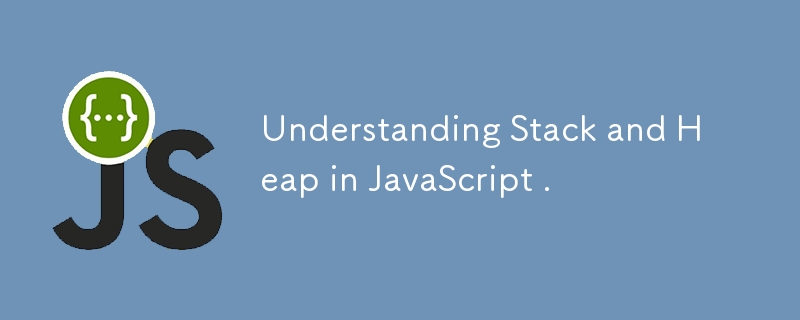了解 JavaScript 中的堆栈和堆。
发布于2024-11-03

在 JavaScript 中,栈和堆是用于管理数据的两种类型的内存,每种都有不同的用途:
- 堆
- 堆
*什么是栈和堆*
堆栈:堆栈用于静态内存分配,主要用于存储基本类型和函数调用。它是一个简单的后进先出 (LIFO) 结构,使其访问速度非常快。
Heap :堆用于动态内存分配,其中存储对象和数组(非基本类型)。与堆栈不同,堆更复杂且访问速度更慢,因为它允许灵活的内存分配。
堆栈内存示例:
let myName = "Amardeep"; //primitive type stored in stack let nickname = myName; // A copy of the value is created in the Stack nickname = "Rishu"; // Now changing the copy does not affect the original value . console.log(myName); // output => Amardeep (Original values remains unchanged since we are using stack) console.log(nickname); // output => rishu (only the copied value will changed)
在此示例中:
- myName 作为原始类型存储在堆栈中。
- 当昵称被分配 myName 的值时,会在 Stack 中创建该值的副本。
- 更改昵称不会影响 myName ,因为它们在内存中是独立的副本。
堆内存示例
现在让我们检查一下堆中如何管理非原始数据类型(对象)。
let userOne = { // The reference to this object is stored in the Stack.
email: "[email protected]",
upi: "user@ybl"
}; // The actual object data is stored in the Heap.
let userTwo = userOne; // userTwo references the same object in the Heap.
userTwo.email = "[email protected]"; // Modifying userTwo also affects userOne.
console.log(userOne.email); // Output: [email protected]
console.log(userTwo.email); // Output: [email protected]
在此示例中:
- userOne 保存对存储在堆中的对象的引用。 -userTwo 被分配相同的引用,这意味着 userOne 和 userTwo 都指向堆中的同一个对象。 -更改 userTwo.email 直接影响 userOne.email,因为两个引用都指向内存中的同一位置。
要点
*堆栈内存*用于存储原始类型和函数调用。每次分配一个值时,都会在堆栈中创建一个新副本。
*堆内存 *用于存储对象和数组。引用同一对象的变量共享内存中的相同内存位置,因此更改一个变量会影响其他变量。
版本声明
本文转载于:https://dev.to/amar_x_vr/understanding-stack-and-heap-in-javascript--11ho?1如有侵犯,请联系[email protected]删除
最新教程
更多>
-
 如何为Apache PHP应用程序配置环境变量?Apache PHP 应用程序的环境变量配置开发依赖环境变量的 PHP 应用程序时,必须清楚地了解如何配置环境变量使用 Apache 时设置这些变量。本文旨在提供有关配置可在 PHP 中访问的环境变量的指导,确保 Web 应用程序的正确运行。具体来说,为同一服务器中的各个域配置单独的环境变量是一种常...编程 发布于2024-11-08
如何为Apache PHP应用程序配置环境变量?Apache PHP 应用程序的环境变量配置开发依赖环境变量的 PHP 应用程序时,必须清楚地了解如何配置环境变量使用 Apache 时设置这些变量。本文旨在提供有关配置可在 PHP 中访问的环境变量的指导,确保 Web 应用程序的正确运行。具体来说,为同一服务器中的各个域配置单独的环境变量是一种常...编程 发布于2024-11-08 -
 如何从 Activity 访问 ViewPager 片段方法?从 Activity 访问 ViewPager Fragment 方法许多移动应用程序使用片段,即代表模块化屏幕部分的独立组件。使用视图分页器管理多个片段可实现流畅的导航和页面动画。有时,开发人员需要在片段中执行特定操作以响应外部事件,例如用户在视图寻呼机上滑动。然而,实现此功能可能会遇到某些挑战。...编程 发布于2024-11-08
如何从 Activity 访问 ViewPager 片段方法?从 Activity 访问 ViewPager Fragment 方法许多移动应用程序使用片段,即代表模块化屏幕部分的独立组件。使用视图分页器管理多个片段可实现流畅的导航和页面动画。有时,开发人员需要在片段中执行特定操作以响应外部事件,例如用户在视图寻呼机上滑动。然而,实现此功能可能会遇到某些挑战。...编程 发布于2024-11-08 -
 如何在 Python 中按列值对散点图着色?按列值对散点图着色在 Python 中,Matplotlib 库提供了多种自定义散点图美观的方法。一项常见任务是根据特定列中的值分配颜色。Seaborn 集成一种解决方案是利用基于 Matplotlib 构建的 Seaborn 库。 Seaborn 提供 sns.relplot 和 sns.Face...编程 发布于2024-11-08
如何在 Python 中按列值对散点图着色?按列值对散点图着色在 Python 中,Matplotlib 库提供了多种自定义散点图美观的方法。一项常见任务是根据特定列中的值分配颜色。Seaborn 集成一种解决方案是利用基于 Matplotlib 构建的 Seaborn 库。 Seaborn 提供 sns.relplot 和 sns.Face...编程 发布于2024-11-08 -
 为什么 fmt.Printf 显示负整数的二进制表示与 Go 中预期的不同?二进制补码和 fmt.Printf:解开二进制表示之谜处理有符号整数时,计算机使用二进制补码来表示负值。这与典型的二进制表示不同,其中符号由单独的位指示。例如,在二进制补码中,整数 -5 表示为 1111 1011。但是,使用 fmt.Printf 打印二进制表示形式可能会产生意外结果。例如,以下代...编程 发布于2024-11-08
为什么 fmt.Printf 显示负整数的二进制表示与 Go 中预期的不同?二进制补码和 fmt.Printf:解开二进制表示之谜处理有符号整数时,计算机使用二进制补码来表示负值。这与典型的二进制表示不同,其中符号由单独的位指示。例如,在二进制补码中,整数 -5 表示为 1111 1011。但是,使用 fmt.Printf 打印二进制表示形式可能会产生意外结果。例如,以下代...编程 发布于2024-11-08 -
 PHP 构造函数属性推广初学者指南PHP 8 引入了一个名为 构造函数属性提升 的奇妙功能。如果您是 PHP 或一般编程新手,这可能听起来有点复杂。但别担心!本博客将通过大量编码示例向您介绍它是什么、为什么有用以及如何使用它。开始吧! 什么是建筑商财产促销? 在 PHP 8 之前,创建具有属性的类并在构造函数中初始化...编程 发布于2024-11-08
PHP 构造函数属性推广初学者指南PHP 8 引入了一个名为 构造函数属性提升 的奇妙功能。如果您是 PHP 或一般编程新手,这可能听起来有点复杂。但别担心!本博客将通过大量编码示例向您介绍它是什么、为什么有用以及如何使用它。开始吧! 什么是建筑商财产促销? 在 PHP 8 之前,创建具有属性的类并在构造函数中初始化...编程 发布于2024-11-08 -
 如何使用 CNTLM 访问工作场所代理后面的 pip?与 CNTLM 的 PIP 代理连接要使用 CNTLM 访问工作场所代理后面的 pip,用户可能会遇到 --proxy 选项的问题。然而,利用环境变量提供了可靠的解决方案。CNTLM 配置验证可以通过运行“cntlm.exe -c cntlm.ini -I -M http://google.com”...编程 发布于2024-11-08
如何使用 CNTLM 访问工作场所代理后面的 pip?与 CNTLM 的 PIP 代理连接要使用 CNTLM 访问工作场所代理后面的 pip,用户可能会遇到 --proxy 选项的问题。然而,利用环境变量提供了可靠的解决方案。CNTLM 配置验证可以通过运行“cntlm.exe -c cntlm.ini -I -M http://google.com”...编程 发布于2024-11-08 -
 如何使用 MySQL 数据库中的时间序列数据填充 JFreechart TimeSeriesCollection?从 MySQL DB 填充 JFreechart TimeSeriesCollection此问题旨在使用 JFreechart TimeSeriesCollection 显示一个月中几天的温度变化。然而,最初的实现面临着从数据库中准确读取数据的挑战。时序数据的精确读取要解决数据读取问题,需要考虑之间...编程 发布于2024-11-08
如何使用 MySQL 数据库中的时间序列数据填充 JFreechart TimeSeriesCollection?从 MySQL DB 填充 JFreechart TimeSeriesCollection此问题旨在使用 JFreechart TimeSeriesCollection 显示一个月中几天的温度变化。然而,最初的实现面临着从数据库中准确读取数据的挑战。时序数据的精确读取要解决数据读取问题,需要考虑之间...编程 发布于2024-11-08 -
 ValueError:无法将 NumPy 数组转换为张量 - 已解决?ValueError: Failed to Convert NumPy Array to Tensor问题描述尝试使用 TensorFlow 训练具有 LSTM 层的神经网络时,出现以下情况发生错误:ValueError: Failed to convert a NumPy array to a T...编程 发布于2024-11-08
ValueError:无法将 NumPy 数组转换为张量 - 已解决?ValueError: Failed to Convert NumPy Array to Tensor问题描述尝试使用 TensorFlow 训练具有 LSTM 层的神经网络时,出现以下情况发生错误:ValueError: Failed to convert a NumPy array to a T...编程 发布于2024-11-08 -
 为什么Java重载不能基于返回类型?Java 中的返回类型重载:不兼容尽管 Java 具有多方面的功能,但该语言在重载函数时还是存在限制仅通过更改返回类型。这就提出了一个常见的问题:为什么 Java 禁止这样的重载?答案在于重载的基本性质。重载允许多个具有相同名称的函数共存于一个类中,并通过它们的参数签名进行区分。然而,当返回类型也用...编程 发布于2024-11-08
为什么Java重载不能基于返回类型?Java 中的返回类型重载:不兼容尽管 Java 具有多方面的功能,但该语言在重载函数时还是存在限制仅通过更改返回类型。这就提出了一个常见的问题:为什么 Java 禁止这样的重载?答案在于重载的基本性质。重载允许多个具有相同名称的函数共存于一个类中,并通过它们的参数签名进行区分。然而,当返回类型也用...编程 发布于2024-11-08 -
 Angular 和 15 的改进1) 在没有构造函数的情况下在 Angular 14 中使用注入注入服务。 以前,注入任何服务总是需要具有构造函数的类: class MyClass { constructor(private myService: MyService) {} } 现在,我们可以在函数和类中注入服务。我们只需要声...编程 发布于2024-11-08
Angular 和 15 的改进1) 在没有构造函数的情况下在 Angular 14 中使用注入注入服务。 以前,注入任何服务总是需要具有构造函数的类: class MyClass { constructor(private myService: MyService) {} } 现在,我们可以在函数和类中注入服务。我们只需要声...编程 发布于2024-11-08 -
 面向对象编程:掌握 DSA 的第一步Imagine you're walking through a bustling factory. You see different machines, each designed for a specific purpose, working together to create a fina...编程 发布于2024-11-08
面向对象编程:掌握 DSA 的第一步Imagine you're walking through a bustling factory. You see different machines, each designed for a specific purpose, working together to create a fina...编程 发布于2024-11-08 -
 如何修复 Android 中的“java.lang.String 类型的值无法转换为 JSONObject”错误?排除“java.lang.String 类型的值\u003cbr\u003e 无法转换为 JSONObject”错误在您的 Android 应用程序中,您遇到与 JSON 解析相关的错误。具体来说,您会看到以下异常:org.json.JSONException: Value <br of t...编程 发布于2024-11-08
如何修复 Android 中的“java.lang.String 类型的值无法转换为 JSONObject”错误?排除“java.lang.String 类型的值\u003cbr\u003e 无法转换为 JSONObject”错误在您的 Android 应用程序中,您遇到与 JSON 解析相关的错误。具体来说,您会看到以下异常:org.json.JSONException: Value <br of t...编程 发布于2024-11-08 -
 如何在 JavaScript 中强制硬刷新并防止缓存问题?解决 JavaScript 缓存问题:使用 JavaScript 清除缓存部署新的 JavaScript 代码时,看不到反映的最新更新是令人沮丧的。此问题通常是由于缓存的浏览器响应而引起的。为了消除这个问题,我们可以利用 JavaScript 函数 window.location.reload(tr...编程 发布于2024-11-08
如何在 JavaScript 中强制硬刷新并防止缓存问题?解决 JavaScript 缓存问题:使用 JavaScript 清除缓存部署新的 JavaScript 代码时,看不到反映的最新更新是令人沮丧的。此问题通常是由于缓存的浏览器响应而引起的。为了消除这个问题,我们可以利用 JavaScript 函数 window.location.reload(tr...编程 发布于2024-11-08
学习中文
- 1 走路用中文怎么说?走路中文发音,走路中文学习
- 2 坐飞机用中文怎么说?坐飞机中文发音,坐飞机中文学习
- 3 坐火车用中文怎么说?坐火车中文发音,坐火车中文学习
- 4 坐车用中文怎么说?坐车中文发音,坐车中文学习
- 5 开车用中文怎么说?开车中文发音,开车中文学习
- 6 游泳用中文怎么说?游泳中文发音,游泳中文学习
- 7 骑自行车用中文怎么说?骑自行车中文发音,骑自行车中文学习
- 8 你好用中文怎么说?你好中文发音,你好中文学习
- 9 谢谢用中文怎么说?谢谢中文发音,谢谢中文学习
- 10 How to say goodbye in Chinese? 再见Chinese pronunciation, 再见Chinese learning

























